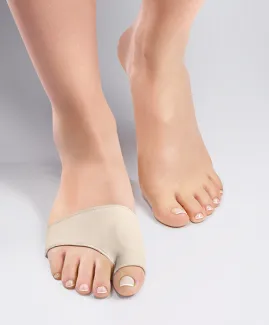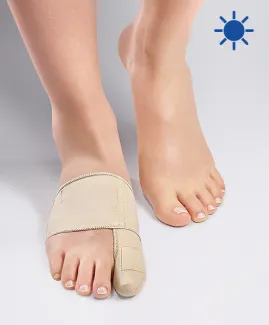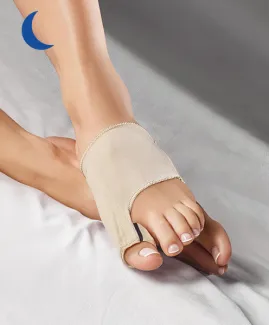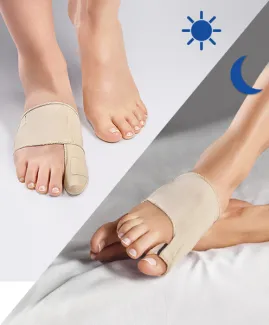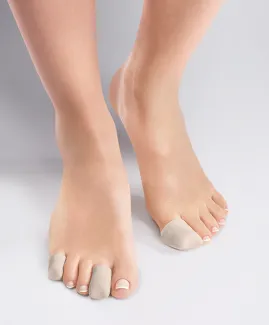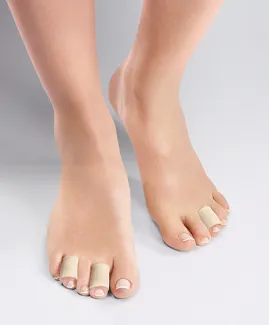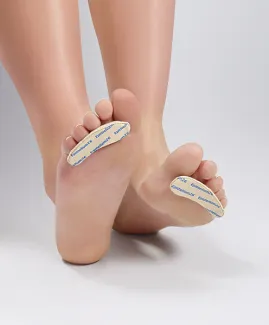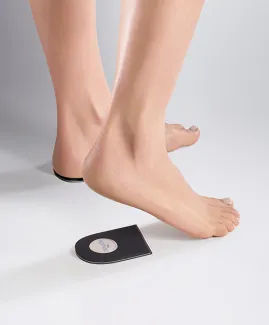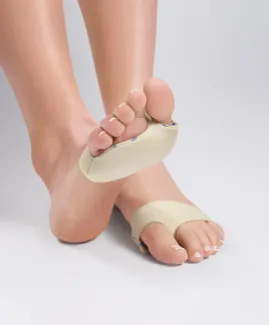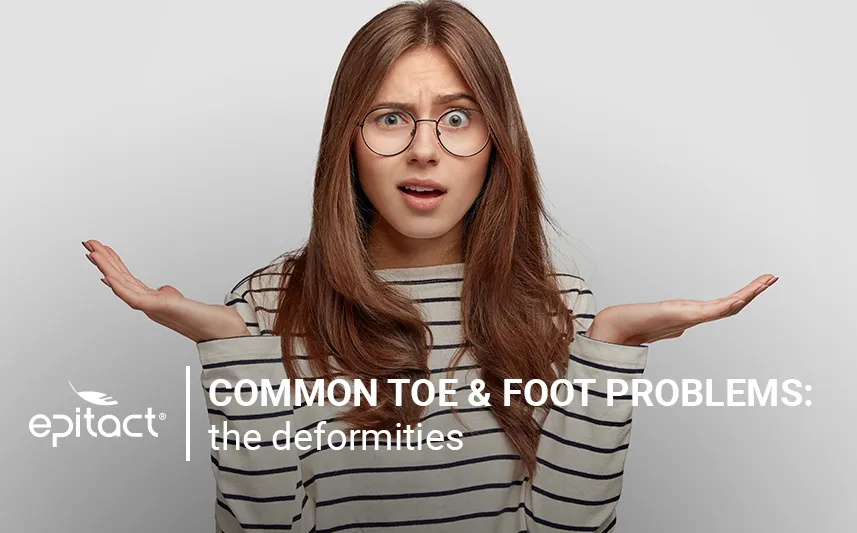
Every day, our feet bear us, make us move, walk and run. More than that, we force them to fit in uncomfortable and tight shoes. Not very surprising though that they often face problems and hurt. Step by step, EPITACT® helps you know what your foot problem is, its causes and how to fight it.
Indeed, as a specialist in foot care products for 25 years, EPITACT® suggests discreet and comfortable protections to relieve and correct the most frequent foot problems. Discover them now!
A list of the most common foot problems and deformities
There are so many lesions likely to affect the foot and each part of it. Here are some of the frequent causes of toe and foot pain and deformities:
- Bunions or hallux valgus;
- Hammer and claw toes;
- Valgus and varus foot;
- Flat and hollow foot;
- Bunionette, Tailor’s bunion or quintus varus;
- Corns and calluses;
- Plantar fasciitis;
- Ingrown toenails;
- Blisters.
Big toe problems: hallux valgus or bunion
Bunions are the most common foot deformities affecting the forefoot. It corresponds to the deviation of the big toe towards the lesser toes. The more it deviates, the more the joint at its base sticks out on the internal side of the foot. This creates the famous bump called bunion.
Causes and solutions for bunions
A bunion is often due to several factors. Egyptian feet are one of them. They are characterised by a gradual length of the toes from the little toe to the big one. Flat feet are another anatomical risk factor of this foot problem. Note that there are more general factors like age, female gender, heredity, excess weight or inappropriate shoes. Knowing that, you can yet limit the risk for your deformity to progress! Put your baskets on and avoid high heels and tight, narrow and rigid shoes.
Plus, if you have advanced hallux valgus, try the EPITACT®’s bunion protector* to relieve pain from the shoe. If you have a mild or moderate deformity, our day bunion corrector* will help realign your big toe when walking. At night, wear our bunion splint* to limit the progression of your bunion. For more details about the treatment of bunions, click here!
Little toe deformity: quintus varus or bunionette
Less popular than a bunion, a bunionette has yet the same pathological process, but this time it affects the little toe. The little toe deviates towards the big toe while the long bone with which it articulates drifts outwards. A bump is then forming on the external side of the foot, at the base of the little toe.
What triggers bunionettes?
A bunionette is usually congenital and so more frequent in children. There are the quintus varus supraductus or infraductus if the little toe goes over or below the fourth toe, respectively. Please note that bunionettes are not always congenital and may result from inappropriate shoes or other foot problems like flat and hollow arches. This deformity can contribute to the development of corns between the toes, called soft corns.
Bunionettes are relieved thanks to a change of shoe habits (less tight), orthopaedic insoles or toe braces in particular.
Flat and hollow foot, varus and valgus foot
Unlike the flat foot, characterised by a too flat arch of the foot, the hollow foot is when the arch is excessively curved. Both foot problems do not necessarily cause pain but can create other foot deformities. For example, flat fleet sometimes tend to collapse inwards, causing the toes to point outwards. This position is called valgus.
On the contrary, the varus position is when the foot leans towards the external side of the foot. The latter foot problem is congenital and may go along with other deformities of the foot and toes.
Causes of sole of the foot problems
These particular foot shapes are often congenital, which means they exist since birth. Because they change the foot structure, loads under the foot are distributed differently and some areas are overwhelmed. At this point, pain can appear resulting from hammer toes, bunions or hyperkeratosis (corns, calluses).
The common treatment for foot problems affecting the arch of the foot are orthopaedic insoles, made to measure by the podiatrist.
Hammer toe deformity
In the case of hammer or claw toes, the deformity more often affects the middle toes. Sometimes, these toe problems are associated with a hollow foot. They are a deformity in which the toe has a shape of hammer or of animal claw: the toe is curved downwards. However, there is a small difference between them: in the hammer toe, the first joint is flexed downwards. In the claw toe, both first and second joints are flexed downwards.
What causes it?
Commonly, hammer and claw toes are caused by muscle imbalance, other deformities (hollow foot, hallux valgus) or inappropriate shoes. In addition to potential joint pain, the flexed joints of the toe are often prone to pressure and friction against the shoe. This is the reason why hard corns often appear on the deformed joint. As load distribution is altered, pressures increase under the forefoot, causing calluses to form progressively. Unlike corns, these areas of hard skin are usually painless.
Treatment for hammer toe problems
The first recommendations for the treatment of hammer toes are to wear shoes with a wide toe box and silicone toe protectors to stop painful pressure with the shoes. A podiatrist can also make orthopaedic insoles and foot care to remove corns on your toes. To “unbend” your toes and so limit the formation of such painful skin lesions, you can wear hammer toe cushions*.
Toenail problems
Bruised, broken and ingrown toenails are common foot problems. Bruised or black toenails are characterised by a collection of blood under the nail (subungual haematoma). When the edge of your toenail (usually of the big toe) grows into the surrounding skin, it is called an ingrown toenail. It is particularly painful because of the inflammation of the skin.
Causes of bruised toenails
Bruises under toenails come with repetitive microshocks of the nail against the shoe. They usually affect the big or the second toe. Poorly trimmed nails or ill-fitting shoes can cause them to appear.
Because bruised toenails mainly appear during sports practice, EPITACT® has created special toe protections for sport*. Made of a patented silicone gel, they absorb microshocks and prevent toenail traumas.
Causes of ingrown toenails
Many factors play a role in the formation of ingrown toenails: nails cut too short, too rounded, with sharp angles, tight shoes, nail or joint deformity (claw toes, hallux valgus, osteoarthritis), etc.
To prevent ingrown toenails from reappearing after the treatment, wear a Digitop*. The silicone gel distributes pressure on the skin and prevents both ingrown toenails and corns on toes.
Ball of foot problems
Ball of foot pain are also called metatarsalgia. They include all the causes for pain at the base of the toes like prolonged standing or calluses for example.
Causes and solution for ball of the foot pain
Pain on the ball of the foot is a consequence of prolonged pressure on the forefoot. Many situations can be implied: prolonged standing as part of a professional or sports activity, being overweight, frequent wear of high heels, foot deformity (e.g.: bunion, hammer toes, hollow foot), etc.
The metatarsal pads* developed by EPITACT® are specifically designed to relieve such pressure. Very thin and comfortable, they fit any type of shoes.
Heel/Foot problems: plantar fasciitis
Plantar fasciitis is the inflammation of a fibrous tissue that covers the bottom of the foot (plantar fascia). You may have heard about heel spurs, which are the result of plantar fasciitis. They are pointy calcium deposits that form where the plantar fascia attached to the heel bone.
Causes of plantar fasciitis
Plantar fasciitis is caused by excessive tension on the plantar fascia. Such stress can be the result of prolonged standing, excess weight, intense sports (running, tennis…) and abnormal foot shapes like flat or hollow feet.
To relieve pain, you must reduce the tension on the fascia. One easy and quick way to do it is to place heel lifts in your shoes. As they slightly raise your heels, it helps to unload the plantar fascia. The EPITACT®heel lifts* have in addition a silicone heart which provides excellent comfort when walking.
Skin problems on the foot: corns and blisters
Corns and blisters are common foot problems affecting the skin, but others exist like mycosis, dry skin, plantar warts…Corns are small areas of thick and hard skin. Most of the time, they form on the top of the toes or between two toes, but they also appear under the forefoot.
Who has not had a blister? These small bubbles under the skin filled with a transparent fluid can form anywhere on the feet but are commonly seen on the back of the heel and toes.
Causes of corns
Corns form on areas of excessive pressure of the shoe over a bony protrusion (end of a toe, joint on the top of a toe, under the metatarsal heads…). All types of shoes that compress the toes (tight, pointed, narrow shoes and high heels) increase the risk of developing corns.
If your corn sits on top of your toe or between two toes, wear a Digitubes® protection* to help it disappear. If your corn is at the end of your toe, rather chose a Digitop*.
Causes of blisters
Blisters are caused by repetitive rubbing between the shoe and the skin. They are common when wearing new shoes or shoes that are too tight or too loose. If your blister is intact, don't pierce it! Instead, apply hydrocolloid protection while it heals. If it is already pierced, disinfect it regularly and leave it to dry naturally.
We use our feet constantly. All day long, they can suffer repetitive shocks, pressure and friction. If, in addition, there is a predisposition to some of the deformities we’ve mentioned above, our feet are particularly vulnerable. For many of the most common toe and foot problems, EPITACT® has an effective solution. We hope you could find the right one for you!
*These solutions are class I medical devices that bear the CE marking under this regulation. Carefully read the instructions before use. Manufacturer: Millet Innovation. 02/2024
 Pharmacie
Pharmacie